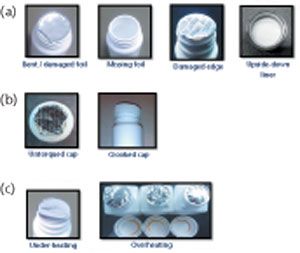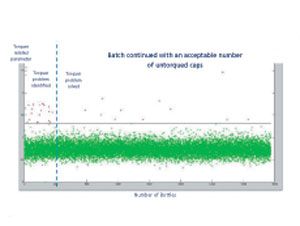Identifying Problems in Induction Sealing
Equipment and Processing Report
Problems in an induction-sealing process, such as untorqued or crooked caps, can be identified and corrected in real time using dynamic thermal imaging.
Primary packaging sealing integrity is crucial in ensuring product viability and shelf life. The days of sampling as the primary means of inspection and analysis for the quality control of pharmaceutical packaging may be nearing an end. One method for non-destructive, 100% inspection of packages is using dynamic thermal imaging to inspect the integrity of induction-sealed bottles. Inspection is performed through closed bottle caps without damaging or degrading the product and without reducing line speeds. Precise data can also be collected to increase understanding of the process, improve quality, and allow operators to detect and amend issues in real-time.
This solution goes beyond the level of accept/reject analysis to also indicate the source in the process that may have caused the faulty seals, including problems related to the raw material, the capper, or the sealer. Incorrect settings can be quickly detected, allowing the immediate removal of defective bottles from the production line and adjustment of the source of the problem. Problems can be corrected in real time, before an entire batch is completed. This process analytical technology (PAT) for the induction-sealing process allows the input and output to be tracked, enabling continuous process verification.
How dynamic thermal imaging works
All objects have a certain temperature and emit waves of energy, called infrared radiation (IR), invisible to the naked eye. In general, hot objects emit more energy than cold objects. A thermal imager creates a viewable image from the IR waves, showing a "heat picture" of a scene.
Thermal imaging was originally developed for the defense industry and is regularly used for military and security applications, as well as non-intrusive inspection of plumbing, electrical systems, and insulation. Combined with high-speed image analysis, this technology provides unique monitoring and detection capabilities that can be used to inspect pharmaceutical primary packaging, specifically, induction sealing.
Induction sealing process problems
In the induction sealing process, as shown in Figure 1, a bottle is filled, and a closure with a composite liner inside is screwed onto the filled container. The container then travels by conveyor under an induction sealer, which uses an electromagnetic field to heat the aluminum foil layer of the liner. The heated foil, in turn, causes the heat-seal layer to melt. When cooled, the polymer creates a bond with the container, resulting in a hermetically sealed product. When the cap is removed, the foil remains, providing an airtight seal and preventing any tampering or contamination of the bottle's contents until the customer pierces the foil. A good induction seal prevents product leakage, is tamper-evident, maintains product quality, and fosters consumer confidence.
Figure 1: Steps of the induction sealing process. All figures are courtesy of the author.

Maximizing the efficacy and efficiency of an induction sealer requires a holistic, carefully coordinated approach that incorporates machine, materials, quality control, and operator education. The container, closure seal liner, and induction sealer must be compatible, and an operating window that allows the sealer to be successful within a range of predetermined operating tolerances must be established. Defects can originate at various steps along a packaging line, including the capper, induction machine, conveyor and, of course, the raw material itself. Potential problem areas are described as follows:
- Material related problems include bent or damaged foil; missing foil; damaged edge or edges; or an upside-down liner (Figure 2a).
- Problems related to the capping equipment include untorqued or crooked caps (Figure 2b).
- Problems tied directly to the sealer itself usually involve overheating or under-heating (Figure 2c).
Figure 2: Problems can be related to materials (a), capping equipment (b), and sealing equipment (c).

Underheating the foil can result in the familiar ‘potato-chip’ effect, as shown in Figure 2c. Overheating the foil can cause damage to the seal layer and to any protective barriers, which could result in faulty seals, even weeks after the initial sealing process. Other sealing problems do not typically originate with the induction sealer but, rather, are associated with a fault earlier in the process that made it impossible for the sealer to perform properly.
Torquer problem case study
In a classic torquer problem, an incorrectly calibrated torquer does not correctly close the cap, and as a result, the induction sealer can not create a proper seal. Figure 3 shows thermal imaging results used to track the process. In the first batch of 2000 bottles, a significant number of rejections (shown as red dots) is seen. This deviation from the defined process window indicates that there is a faulty process that should be stopped and the source of the problem checked before more bottles are incorrectly sealed. The rejections in this case were discovered to be associated with the tightness of the cap. Based on this information, the line operator stopped the line and adjusted the torquer. The batch was then continued and rejections return to an acceptable number, as shown in Figure 3.
Figure 3: Thermal imaging tracks the induction-sealing process and indicates rejected bottles (red dots).

Conclusion
Given the myriad potential problem areas, the need for a troubleshooting process that assures the highest possible level of quality control is clear. In each of these cases, use of dynamic thermal imaging allows the operator to identify the problem early, stop the line, immediately remove any defective bottles, and make necessary corrections to the production line process. Preventing issues before they become significant problems minimizes the cost of wasted time, work-backs, materials, and labor. This real-time, non-intrusive monitoring of package integrity is currently in use on packaging lines at several leading pharmaceutical packaging companies.
About the Author
Fabian Schapiro is the VP Marketing and Sales of DIR Technologies, www.dir-technologies.com.
Article Details
This article first appeared in
Pharmaceutical Technology
Vol. 39, No. 11
Pages: 50–51
Citation:
When referring to this article, please cite it as F. Schapiro, "Using Dynamic Thermal Imaging to Correct Sealing Problems," Pharmaceutical Technology 39 (11) 2015.
3D Screen Printing: Enabling A New Generation of Complex Formulations
April 14th 20253D screen printing provides innovative drug development capabilities that are difficult or impossible to achieve with traditional methods, including complex multi-layered formulations, precision control over drug release profiles, and near-endless possibilities in the geometric shaping of dosage forms. In this article, learn how 3D screen printing offers unmatched flexibility to tailor formulations for specific therapeutic needs and redefines what’s possible in drug development and manufacturing.
Transformations in Drug Development for Cell and Gene Therapies
March 28th 2025As a recognized leader in immunophenotyping for clinical trials, Kevin Lang from PPD discusses how spectral flow cytometry is transforming drug development, particularly in cell and gene therapies like CAR-T. He also dives into his award-winning research, including his 2024 WRIB Poster Award-winning work, and his insights from presenting at AAPS PharmSci360.
Advancing Clinical Trials with Spectral Flow Cytometry: A Conversation with Kevin Lang
March 28th 2025As a recognized leader in immunophenotyping for clinical trials, Kevin Lang from PPD discusses how spectral flow cytometry is transforming drug development, particularly in cell and gene therapies like CAR-T. He also dives into his award-winning research, including his 2024 WRIB Poster Award-winning work, and his insights from presenting at AAPS PharmSci360.
